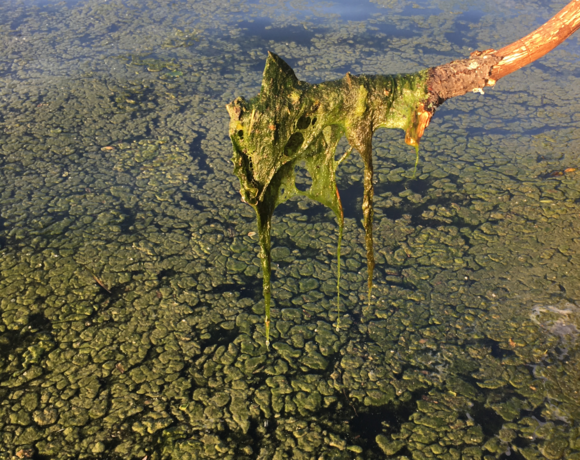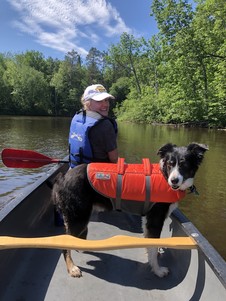
This month brings warm and sunny times when both Wisconsin lake-goers and blue-green algae are living their best lives.
Having already received nine illness complaints this season, the DHS Harmful Algal Blooms (HAB) Program has been busy protecting public health from harmful exposures to blue-green algae and the toxins they can produce. One way we do this is by assisting local and Tribal health departments with communicating about HABs. We help develop signage, review draft press releases, and provide example social media posts and risk-messaging. We want to ensure recreators have accurate information about blue-green algae—what they are and what they look like—and how they can recognize and report potentially related illnesses.
Unfortunately, it is not uncommon to see blue-green algae portrayed in a misleading and inaccurate light, especially in the media. This keeps us busy as public health communicators because we often must set the facts straight. Headlines such as “Wisconsin man suspects lake algae toxins killed dog,” “Deadly algae return to National Park,” and “Killer algae? State officials retesting river water after family found dead” are sensationalist and misleading. The media often uses footage of filamentous green algae (pictured below) in stories about blue-green algae, further complicating public health messaging.
 Unlike cyanobacteria, filamentous green algae are true algae and do not produce toxins. Filamentous algae grow from the bottoms of lakes. They can flourish and produce faux "blooms" when their stringy filaments rise to the surface of the water, as pictured above. To tell the difference between filamentous green algae and blue-green algae, conduct the "stick test": Dip a large stick into the material and try to lift it out of the water. If you retrieve long, stringy, hair-like material, chances are you have filamentous algae. If it comes out looking as if it was dipped in paint, chances are that you have blue-green algae.
Using words like “deadly” and “killer” when referring to blue-green algae is alarmist and can incite panic to readers. While blue-green algae toxins have been responsible for the deaths of dogs and other animals, no human deaths in the United States have been definitively linked to them. In one rare event that took place at a dialysis center in Brazil, a type of liver cyanotoxin called microcystin was present at high levels in the water used for hemodialysis. Patients who underwent dialysis at this center suffered severe illness and many died from cyanotoxin exposure. Read the article to learn more about this unique case study.
Effective Communication During a Public Health Crisis
Having accurate and unalarming information is especially important during a crisis. People often face greater challenges understanding and remembering messages when panicked and stressed. Communicating effectively is crucial to ensure people understand the situation at hand and know how to protect themselves, their families, and their pets. The CDC has developed a Crisis and Emergency Response (CERC) Manual with guidance to help public health officials respond to crises and communicate appropriately with their community. Below are communication tactics listed in the CERC manual:
-
Present a concise message. When people are scared or anxious, they have a hard time taking in and remembering large amounts of information. Keep the first messages simple and only include immediately relevant information. Do not start with a lot of background. Avoid jargon and technical terms.
-
Repeat the main message. Reach and frequency are essential for protecting the public with your first messages. Repetition helps people remember the message, especially during an emergency when memory retention is shorter due to anxiety and racing thoughts.
-
Give action steps in positives. Whenever possible, use positive messages such as “drink bottled water” or “boil drinking water,” instead of negatives like, “do not drink the water.” Words like “no” and “not” can be easily confused or forgotten in moments of heightened emotion and background noise. Additionally, simply telling someone not to do something can leave them unsure and looking for acceptable action steps.
Note: Sometimes action can only be conveyed clearly by using the negative. One example is the message to pregnant women to protect them from the Zika virus: “Pregnant women should not travel to areas with risk of Zika.” Saying, “Pregnant women should travel to areas without risk of Zika” does not clearly convey what pregnant women need to do to stay safe.
-
Create action steps in threes or fours. During normal times, people tend to only remember three to seven pieces of information at a time. In an emergency, this drops down to only three simple directions. Some good examples are “stop, drop, and roll” for response to fire, and “separate, cook, and chill” for food safety.
-
Use personal pronouns. Using personal pronouns when communicating on behalf of your organization personalizes the message and helps with credibility and cohesion. Use phrases such as, “We are committed to…” or “We understand the need for…”
-
Respect people’s fears and perceptions. Do not judge or use condescending phrases. Instead, say things like “It is normal to feel anxious during times like these.”
-
Give people options. Avoid being paternalistic. Instead of telling them what to do, give people options and inform their decisions.
-
Avoid humor. Humor is never a good idea in emergency communications. Be cautious not to offend others and remain sensitive, especially in public. Be aware that cell phones and microphones left live can easily capture “behind-the-scenes” moments.
Now for the fun part! Let’s apply these tactics to a HAB crisis. Picture this:
 |
|
Summer in Wisconsin is in full “bloom”. People are taking advantage of the warm weather by engaging in recreational activities like swimming, boating, and water skiing. Animals are enjoying the water, too! Pet owners are bringing along their furry friends to join in on the fun.
Blue-green algae are also taking advantage of the warm weather. Some Wisconsin water bodies are experiencing blue-green algae blooms. On one especially hot August afternoon, you receive news that a dog has died after swimming and playing in Lake Crystal Clear, a water body in your county. The dog’s owner believes the death was attributed to blue-green algae. News is spreading quickly. The owner is telling everyone she can think of—family, friends, and even the local news. Social media posts about this incident are popping up on Facebook, Instagram, and TikTok!
|
Panic is beginning to arise from the public. You’re receiving numerous emails and phone calls from concerned citizens about whether the water at Lake Crystal Clear is safe and wanting an explanation for the dog’s death. The media is pressuring you to provide a response to the community.
Is this an ideal situation? No. But will you be prepared to address it? Yes. You can help your community by using CERC’s public health messaging tactics:
-
Present a Concise Message. "When blue-green algae grow to high levels, they can produce toxins that may cause illness in humans and animals. We do not yet know the cause of the dog's death but are working closely with blue-green algae and animal health experts to investigate the death and test the water at Lake Crystal Clear. We are committed to protecting the health of this community and our beloved pets, and that is why the public swimming beach will remain closed until we receive results and learn more."
-
Repeat the main message. Include the message above in multiple formats to maximize reach—in a press release, on your website, in a social media post, etc. Remember—DHS has messaging templates at the ready!
-
Give action steps in positives (when feasible).
- "Keep pets out of discolored water or where you see foam, scum, or mats of algae."
- "If dogs do swim in scummy water, rinse them off with fresh, clean water, and discourage them from licking algae off their fur."
- "Be on the lookout for water quality notices and avoid swimming in areas where health advisories or closures are posted. Not all beaches will have these signs, so it is important to always assess conditions yourself before you or your pet go swimming."
- "If you suspect you or your pet has become ill from blue-green algae, please report your illness."
-
Create action steps in threes or fours. "Know it! Avoid it! Report it!"
-
Use personal pronouns. "We are committed to protecting the health of this community and ensuring the safety of you, your family, and your pets."
-
Respect people’s fears and perceptions. "Pets are an important part of many people’s lives. It is normal to feel sad about this tragedy and to have concern over the cause of the dog's death."
-
Give people options. "We encourage you to find a safer, alternative spot to swim. Use the visual guide in the What You Need to Know about Blue-Green Algae fact sheet to help you identify and avoid blue-green algae. If you’re not sure whether the water is safe to swim in, it is best to err on the side of caution. When in doubt, stay out!"
-
Avoid Humor. Stating a bad joke such as, “Curiosity may have killed the cat, but blue-green algae killed this dog!” is not appropriate in this situation. You will most likely have to face some upset and angry citizens if you say or publish something like this!
Want to learn more? Visit the following communications resources:
 |
|
Lets Get Social!
This issue’s sample post and free-use photo
|
Did you know that blue-green algae blooms have look-alikes? Learn the difference and when in doubt, stay out!

Stay in Touch
 |
|
Miss a past issue? Previous issues are available on our Resources for Health Professionals webpage.
Email us your burning questions! If others can benefit from hearing the answer to your question, we’ll feature it in a future issue.
Remember that we are always available for consultation on any HAB health-related issue by email or phone at 608-266-1120.
|
|